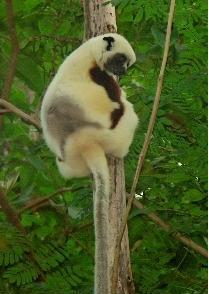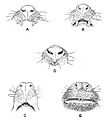Strepsirrhini facts for kids
Quick facts for kids StrepsirrhiniTemporal range: Early Eocene - Recent
|
|
|---|---|
 |
|
| Coquerel's Sifaka (Propithecus verreauxi) | |
| Scientific classification | |
| Kingdom: | |
| Phylum: | |
| Class: | |
| Order: | |
| Suborder: |
Strepsirrhini
E. Geoffroy, 1812
|
Strepsirrhines are a group of primates, which includes 114 different kinds of animals. They are known for their wet noses, even though their Greek name means "having a curved or bent nose." Most strepsirrhines live in Madagascar, which is an island off the coast of Africa. They are the only primates found there, besides humans. You can also find some strepsirrhines in parts of southeast Asia.
These animals have special eyes with a reflective layer. This layer helps them see much better at night. Their eye sockets also have a ring of bone around the eye, which is another unique feature. Unlike some other primates (including us!), strepsirrhines can make their own vitamin C inside their bodies.
This group of primates includes well-known animals like lemurs and lorises. Scientists believe that modern strepsirrhines probably evolved from an ancient, extinct group called Adapiforms.
Contents
What Are Strepsirrhines?
Strepsirrhines are one of the two main groups, or suborders, of primates. The other group is called haplorhines, which includes monkeys, apes, and humans. Strepsirrhines have several features that set them apart. Their wet noses are a key characteristic, helping them with their sense of smell. They also tend to have longer snouts compared to haplorhines.
Special Features for Night Life
Many strepsirrhines are active at night. Their special reflective eye layer, called a tapetum lucidum, helps them gather more light. This makes it easier for them to see in dim conditions. This adaptation is very useful for finding food and moving around in the dark.
Their Unique Diet Needs
An interesting fact about strepsirrhines is their ability to produce their own vitamin C. Most other primates, including us, need to get vitamin C from the food they eat, like fruits and vegetables. This difference shows how strepsirrhines have adapted over a very long time.
Where Do Strepsirrhines Come From?
The exact beginning of all primates, including strepsirrhines and haplorhines, is still a bit of a mystery. Scientists are not completely sure where the first primates lived or which animal group they evolved from.
Clues from Fossils and Genes
Even though we have many fossils from when primates first spread across the Northern Hemisphere, there are not many fossils from the tropics. This is where scientists think primates most likely first appeared.
Because of this, scientists who study genetics and primates use genetic analyses to figure out how different primate groups are related. They also use a "molecular clock" to estimate when these groups separated from each other. Based on this, it seems that primates first appeared more than 80 to 90 million years ago. This is much earlier than the first primate fossils we have found!
Strepsirrhine Family Tree
The Strepsirrhini group is divided into smaller families. Here's a look at their main branches:
- Suborder Strepsirrhini: This includes all the non-tarsier prosimians.
- Infraorder Lemuriformes
- Superfamily Lemuroidea (These are the lemurs)
- Family Cheirogaleidae: This family includes dwarf and mouse lemurs (32 species).
- Family Daubentoniidae: This family has only one species, the Aye-aye.
- Family Lemuridae: This family includes many different lemurs (22 species).
- Family Lepilemuridae: These are the sportive lemurs (26 species).
- Family Indriidae: This family includes woolly lemurs and their relatives (19 species).
- Superfamily Lorisoidea (These are the lorises and galagos)
- Superfamily Lemuroidea (These are the lemurs)
- Infraorder Lemuriformes
Images for kids
-
This slender loris shows how early primates could move well on thin branches.
-
É. Geoffroy first suggested the suborder Strepsirrhini in 1812.
-
The fossil ""Ida"" caused some confusion about strepsirrhines when it was first found.
-
Strepsirrhines usually have a longer snout and a wet nose compared to haplorhine primates.
-
Strepsirrhines are in danger because of deforestation (trees being cut down) in tropical areas.
See also
 In Spanish: Strepsirrhini para niños
In Spanish: Strepsirrhini para niños










